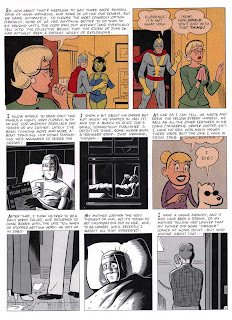
I recently read with interest this examination of books that never existed outside of fiction on the Guardian Book Blog. In that discussion of Borges-style imaginary books like The Blind Assassin from the Margaret Atwood novel of the same name, a poster in the comments section mentioned several apocryphal novels glimpsed fleetingly in a sequence from Neil Gaiman's Sandman comic book. The post made me think about my favourite examples of "fictional" comic books and cartoon characters, as featured in some classic comics and graphic novels.
5. "The Comic Book Archer" (Adventure Comics 269) by Robert Bernstein and Lee Elias
In this 1960 story, superhero and Robin Hood imitator Green Arrow tries to help a young comic book artist get published in "All-Star Comics" by reproducing the feats of the cartoonist's creation, "Wizard Archer." This is a fun little gem from the Silver Age of U.S. comics that features a self-referential, behind-the-scenes peek at a DC-like comics company, in which caricatures of writer Robert Bernstein and cartoonist Lee Elias appear to explain how comic books are made ("The artists draw whatever the writers tell them to in their scripts!"). Of course, the upshot is that Green Arrow proves the archery tricks that appear in the comic can actually be accomplished in "real life" and so Wizard Archer appears in the next issue of All-Star, which finds a space on the shelves alongside Atlantis Comics, The Golden Avenger, and Western Heroes. (this story is reprinted in Showcase Green Arrow)
4. Watchmen by Alan Moore and Dave Gibbons (DC)
The comic-within-a-comic of this graphic novel is the famous Tales from the Black Freighter, the pirate comic and Brecht-reference that answers the question, what kind of comics would kids read in a world where superheroes are real? Text pieces in the book suggest that Tales was part of a larger pirate genre, spear-headed by EC's Piracy. The pirate story "Marooned" is used by Moore as part of the elaborate system of parallels and gothic devices that make up the bally-hooed structure of Watchmen and still reads today as an affecting piece of purple prose, regardless of the repellent stiffness of Gibbons drawings.
3. Hicksville by Dylan Horrocks (Drawn and Quarterly)
This graphic novel about an American journalist investigating the bizarre secrets of a small New Zealand town is equal parts ode to comics and metatextual exegisis of comics storytelling. It also contains more than its fair share of imaginary comics (or comics-within-comics), including Captain Tomorrow -- the creation of New Zealand ex-pat Dick Burger, an autobiographical minicomic by Burger's ex-assistant Sam Zabel, and mysterious about maps, Maori, and Captain Cook. At the heart of the book lies the mystery of the Hicksville Lighthouse, repository of all of the great comic might-have-beens, the mythical comics that the world's greatest artists and writers would have created if not constrained by commerce and the philistinism of comic book production in the 20th Century. Thus, we are treated to the exquisite idea of Harvey Kurtzman's magnum opus History of War, lying alongside lost works by Jack Kirby, Picasso, Winsor McCay, and untold hundreds of others.
2. David Boring by Daniel Clowes (Pantheon)
This graphic novel has been described by Clowes as "Fassbinder meets half-baked Nabokov on Gilligan's Island" and largely resists summarization. It deals in small part with efforts of the eponymous lead to learn more about his father, a cartoonist who worked on a superhero comic book called The Yellow Streak. The single extant issue of the comic book exists only in fragmented form, having been torn up by Boring's mother. Piecing together the few panels of the comic remaining, it appears that the Yellow Streak comic is a synthesis of Superman and Johnny Thunder, but the story is mostly unreadable, portraying a weird Freudian nightmare universe akin to the world created by Wayne Boring and other artists of the Weisinger-era Superman comics, the world of Jimmy Olsen and the Phantom Zone. Boring's efforts to make sense of these fragments, trying to find some reference to the real world history or psyche of his father form one of the major subplots of the book and relate to Clowes' recurring themes of alienation and authenticity.
1.
Wimbledon Green by Seth (D+Q)
Seth's first graphic novel, It's a Good Life If You Don't Weaken, introduced us to the fictional New Yorker cartoonist Kalo, one of the great hoaxes of modern comics. Seth wrote an introduction to Horrock's Hicksville and seems to have a soft spot for imaginary comics. Wimbledon Green is the story of an Uncle Scrooge-like comic collector who criss-crosses the country looking for the world's most rare and obscure comics, including such gems as The Green Ghost #1 (the Holy Grail of comics collectors), All Bedtime Comics and Mighty Orbit. But the cream of Wimbledon Green's collection is the classic hobo comic book, Fine and Dandy, a wonderful series that recalls 30s comic strips, Laurel and Hardy, and the work of John Stanley, a Seth touchstone and idol.




No comments:
Post a Comment